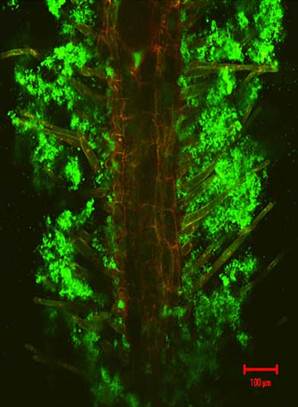JoeReal
Site Admin


Joined: 16 Nov 2005
Posts: 4726
Location: Davis, California
|
| Posted: Sat 18 Oct, 2008 2:14 am |
|
But not in a way you think about it. Be sure to read the report.
| Quote: | When injured, plants cry for help
If under attack by a pathogen, plant's leaf sends an S.O.S to the roots

Image: Bacillus subtilis
Thimmaraju Rudrappa
The green represents the beneficial bacterium Bacillus subtilis, which has formed a biofilm on the roots of Arabidopsis after the leafs sent down a cry of help.
When injured, plants can cry for help via a chemical phone call to the roots.
If under attack by a pathogen , such as disease-causing bacteria, a plant's leaf can send out an S.O.S. to the roots for help, and the roots will then secrete an acid that brings beneficial bacteria to the rescue, scientists announced today. The finding builds on research earlier this year showing that parasitic plants can tap into a host plant's communication system.
"Plants are a lot smarter than we give them credit for," said Harsh Bais, assistant professor of plant and soil sciences at the University of Delaware. "People think that plants, rooted in the ground, are just sitting ducks when it comes to attack by harmful fungi or bacteria , but we've found that plants have ways of seeking external help," he notes.
To figure this out, Bais and colleagues infected the leaves of the small flowering plant Arabidopsis thaliana with a pathogenic bacterium, Pseudomonas syringae. The plants started to look sickly.
However, the infected plants whose roots had been inoculated with the beneficial microbe Bacillus subtilis were perfectly healthy.
Farmers often add B. subtilis to the soil to boost plant immunity. It forms a protective biofilm around plant roots and also has antimicrobial properties, Bais said.
Using molecular biological tools, the scientists detected the transmission of a long-distance signal, a call for help, from the leaves to the roots in the plants that had Bacillus in the soil. The roots responded by secreting a carbon-rich chemical malic acid.
All plants biosynthesize malic acid, Bais explains, but only under specific conditions and for a specific purpose. In the lab tests, the chemical was actively secreted to attract Bacillus. Magnified images of the roots and leaves showed the ratcheted-up defense response provided by the beneficial microorganisms.
The scientists are now trying to figure out exactly what the signal is that's sent down to the roots.
The research, funded by the National Science Foundation and the university, will be detailed in the November issue of the journal Plant Physiology.
|
Joe's (not the plumber, but the Real one) speculation: I can't help but think that such a microorganism may be found in the roots of citruses to help them out when attacked by HLB pathogens. This theory has very sound ecological principle and it strikes me that I have never thought about this before, nor have read about it. Kudos to the people who published this.
When it comes to citruses, the trick is to find out, through research, if such type of microorganism exists for citruses. The report has sparked my speculation and imagination. This could be another potential solution worth looking at. One of the clues could be reviewing the root microorganism assays of citrus cultivars that are healthy growing where the HLB pressure is too high. There are several millions of citruses out there that were not decimated by this plague. Asia and Brazil still have many citrus acreage standing, it may be wise to look there for the clue, and one of them is to look at the microbial community of the roots of healthy citrus trees growing amidst the greening disease hell. When citrus plants cry for help, make sure our microscopic friends are down there to help. Let our research institutions spend the money to find out if such citrus friends exists, this is another unique solution waiting to be discovered. This has been discovered in other species as shown by the above report. |
|




